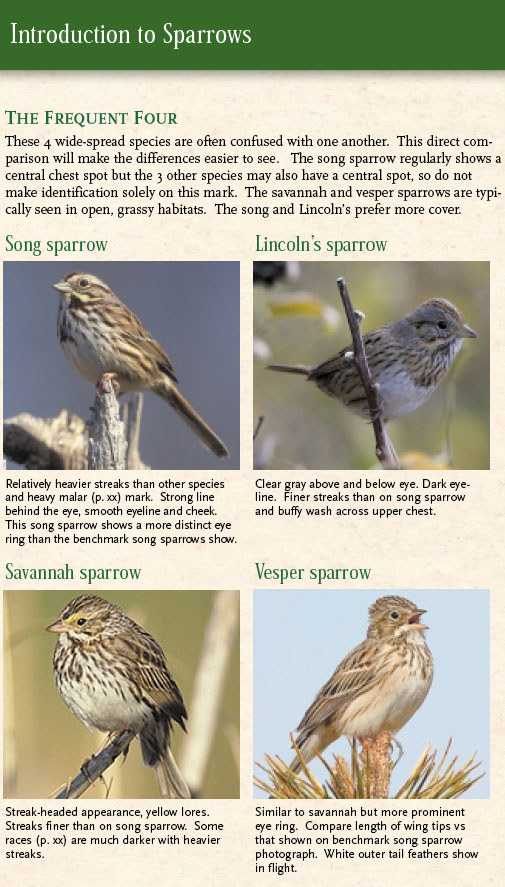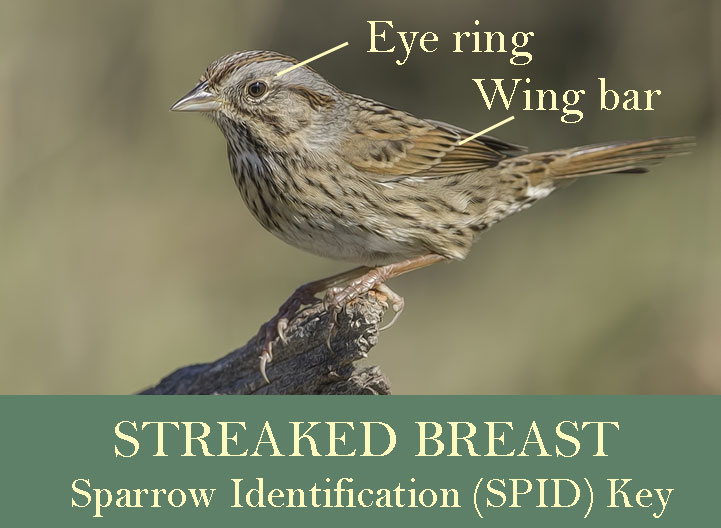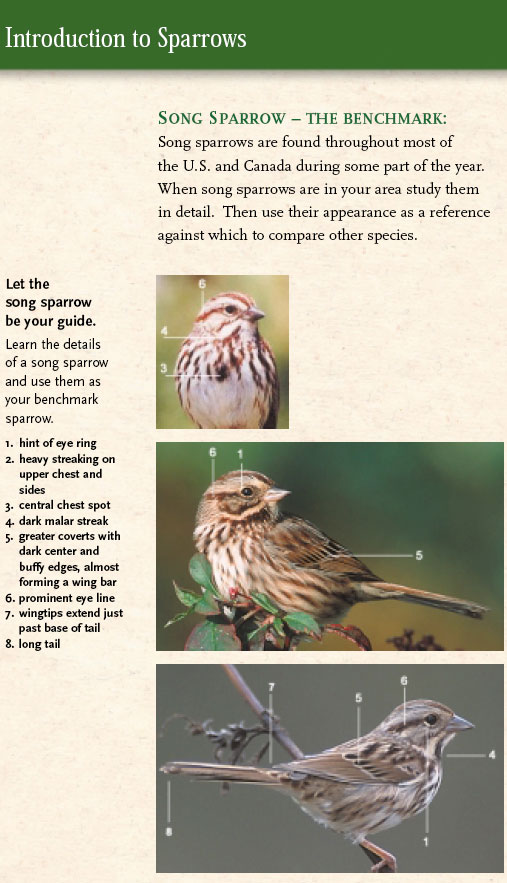
In this guide, we will introduce you to the guide to identify sparrows.
On this page
Identification of the Song Sparrow, Lincoln’s Sparrow, Savannah Sparrow and Vesper Sparrow.
These 4-widespread species are often confused with on another. This direct comparison will make the differences easier to see. The song sparrow regulary shows a central chest spot, but the 3 other species may also have a central spot, so do not make identification soley on this mark. The savannah and vesper sparrow are typically seen in open, grassy habitats. The song and Lincoln´s prefer more cover.
Song Sparrow
Relatively heavier streaks than other species and heavy malar (p.xx) mark. Strong line behind the eye, smooth eyeline and cheek. This song sparrow shows a more distinct eye ring than the benchmark song sparrow shows.
Lincoln Sparrow
Clear gray above and below eye. Dark eyeline. Finer streaks than on song sparrow and buffy wash across upper chest.
Savannah Sparrow
Streak-headed appearance, yellow lores. Streaks finer than on song sparrow. Some races( p.xx) are much darker with heavier streaks.
Vesper Sparrow
Similar to savannah but more prominent eye ring. Compare length of wing tips vs that shown on benchmark song sparrow photograph. White outer tail feathers show in flight.
Sparrow Identification (SPID Key)
Keys are widely used to identify plants and insects. They are used less often with birds because of the variations in plumage based on time of year, race, age and sex. Nevertheless, when used with caution they can be helpful.
Use the two keys (sparrows with a clear breast and sparrows with a streaked breast) to assist your identification process. It will not work with every sparrow but will often point you in the right direction and the process of using the key will help you develop your identification skills.
Remember that poor lighting conditions and plumage variations may affect your ability to see the field marks used in the key.
The keys work in three steps, using the following criteria:
- Is the breast streaked or clear?
- Does the bird have wing bars ?
- Does the sparrow have an eye ring?
*The key is for adult birds.
Keep in mind that wing bars and eye rings may be more or less visible depending on the time of year, age of the bird, lighting and distance from the observer.
When observing a sparrow that you do not recognize, start by making a note (mental or, even better, written) of all the distinguishing characteristics you can see, including the marks in our key. Many birders find that if they say (quietly when observing the bird) what they see, they can remember it better.
After selecting either streaked or un-streaked, work the key from the top to the bottom.
You may need to work back and forth (up and down, actually). If you think the sparrow in question has a wing bar but the descriptions of the birds under this category clearly do not fit, then move down to the “Faint or No Wing Bar” list of birds and try again. (Feather wear or lighting could cause the bird to look like it has a wing bar.)
You’ll soon get the hang of working the key back and forth and coming up with the best fit.
Unfortunately, often you can see only one side of a bird and some field marks may not be visible. The key may not help in this situation or you may still be able to jump to a section (like clear breast and eye ring) even if you could not see the wings.
Note: Juvenile sparrows often have streaked breasts, even if they have a clear breast in adult plumage. Five-striped, Rufous-winged and Botteri’s sparrow are not in the key because of their very limited range. Juncos and Lark Bunting are also not included in the key.
We do not expect the keys to help you identify every sparrow you see. The process of working through the keys will raise your awareness of, and attention to, key marks that separate the different species. Experience in the field is the key to good sparrow identification.
Streaked Breast Sparrow (SPID Key)
 Wing bar – yes
Wing bar – yes
- Harris Sparrow
Eye Ring- yes, including partial
none
Eye ring – faint or none
Harris Sparrow – streaks on side, black on crown, around bill and throat, white belly, fave of winter birds almost golden look. Wingbars in winter adults are buffy.
Wing bar – faint or none
- Sage
- Henslow’s
- Vesper
- Le Conte’s
- Nelson’s Sharp-Tailed
- Saltmarsh Sharp-Tailed
- Seaside
- Savannah
- Fox
- Song
- Lincoln’s
- Baird’s
Eye Ring- yes, including partial
Sage Sparrow – gray or brown head, white spot in front of eye
Henslow’s Sparrow – greenish eyebrow and nape
Vesper Sparrow – fine streaked head/white outer tail feathers, no yellow over eye
Le Conte’s Sparrow – orangish over eye, gray in front of the eye, buffy upper breast with fine streaks, buffy flanks with heavier streaks, eye ring may be weak. Found in grassy fields. Nelson’s and Saltmarsh Sharp-Tailed Sparrows are similar, but found in grassy marshes.
Baird’s Sparrow – buffy eyebrow behind eye, breastband streaks from necklace
Song and Lincoln’s Sparrows – some birds show stronger eye ring, but are described below
Eye ring – faint or none
Nelson’s Sharp-Tailed Sparrow – orangish over eye, gray back of neck, orange across breast
Saltmarsh Sharp-Tailed Sparrow – orangish over eye, gray back of neck, pale buff on sides, paler in the center of the breast
Seaside Sparrow – very dark, white throat
Savannah Sparrow – faint eye ring, yellowish lores over eye. Variable, overall streaked look
Fox Sparrow – grayish (east), reddish (west), very heavy, often arrow-head shape, spots/streaks on chest and side
Song Sparrow – streaks on sides and upper breast, central spot, greyish above and below eye
Lincoln’s Sparrow – fine straks on side and upper chest, place buffy wash on chest, spiffy look
Tips on identifying the Song Sparrow
The benchmark
Song sparrows are found throughout most of the U.S and Canada during some part of the year. When song sparrows are in your area study them in detail. Then use their appearance as a reference against which to compare other species.
Let the song sparrow be your guide.
Learn the details of a song sparrow and use them as your benchmark sparrow.
- hint of eye ring
- heavy streaking on upper chest and sides
- central chest spot
- dark malar streak
- greater coverts with dark center and buffy edges, almost forming a wing bar
- prominent eye line
- wingtips extend just past base of tail
- long tail

